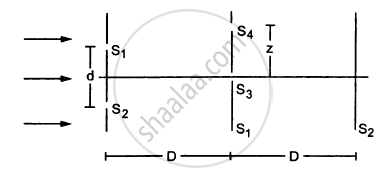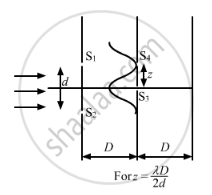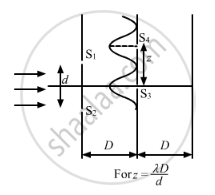Advertisements
Advertisements
Question
Consider the situation shown in the figure. The two slits S1 and S2 placed symmetrically around the central line are illuminated by a monochromatic light of wavelength λ. The separation between the slits is d. The light transmitted by the slits falls on a screen ∑1placed at a distance D from the slits. The slit S3 is at the central line and the slit S4 is at a distance z from S3. Another screen ∑2 is placed a further distance D away from ∑1.Find the ratio of the maximum to minimum intensity observed on ∑2 if z is equal to

(a) \[z = \frac{\lambda D}{2d}\]
(b) \[\frac{\lambda D}{d}\]
(c) \[\frac{\lambda D}{4d}\]
Solution
Given:
Separation between the two slits = d
Wavelength of the light = \[\lambda\]
Distance of the screen = D
The fringe width (β) is given by \[\beta = \frac{\lambda D}{d}\]
At S3, the path difference is zero. So, the maximum intensity occurs at amplitude = 2a.
(a) When \[z = \frac{D\lambda}{2d}\]
The first minima occurs at S4, as shown in figure (a).
With amplitude = 0 on screen ∑2, we get
\[\frac{l_{max}}{l_{min}} = \frac{\left( 2a + 0 \right)^2}{\left( 2a - 0 \right)^2} = 1\]

(b) When \[z = \frac{D\lambda}{d}\]
The first maxima occurs at S4, as shown in the figure.

With amplitude = 2a on screen ∑2, we get
\[\frac{l_\max}{l_\min} = \frac{\left( 2a + 2a \right)^2}{\left( 2a - 2a \right)^2} = \infty \]
(c) When \[z = \frac{D\lambda}{4d}\]

The slit S4 falls at the mid-point of the central maxima and the first minima, as shown in the figure.
Intensity \[= \frac{l_\max}{2}\]
\[ \Rightarrow \text{Amplitude }= \sqrt{2}a\]
\[\therefore \frac{l_\max}{l_\min} = \frac{\left( 2a + \sqrt{2}a \right)^2}{\left( 2a - \sqrt{2}a \right)^2} = 34\]
APPEARS IN
RELATED QUESTIONS
Monochromatic light of frequency 6.0 × 1014 Hz is produced by a laser. The power emitted is 2.0 × 10−3 W. Estimate the number of photons emitted per second on an average by the source
'Two independent monochromatic sources of light cannot produce a sustained interference pattern'. Give reason.
In the wave picture of light, the intensity of light is determined by the square of the amplitude of the wave. What determines the intensity in the photon picture of light?
What kind of fringes do you expect to observe if white light is used instead of monochromatic light?
State the essential conditions for diffraction of light ?
When monochromatic light travels from a rarer to a denser medium, explain the following, giving reasons:
(i) Is the frequency of reflected and refracted light same as the frequency of incident light?
(ii) Does the decrease in speed imply a reduction in the energy carried by light wave?
State Huygen’s principle. Using this principle explain how a diffraction pattern is obtained on a screen due to a narrow slit on which a narrow beam coming from a `=> n = (vlamda)/(vlamda_omega)`monochromatic source of light is incident normally.
If a monochromatic source of light is replaced by white light, what change would you observe in the diffraction pattern?
Which of the following sources provides the best monochromatic light?
Can the interference pattern be produced by two independent monochromatic sources of light? Explain.
State with reason, how the linear width of the central maximum will be affected if
(i) monochromatic yellow light is replaced with red light, and
(ii) distance between the slit and the screen is increased.
Answer the following question.
In the diffraction due to a single slit experiment, the aperture of the slit is 3 mm. If monochromatic light of wavelength 620 nm is incident normally on the slit, calculate the separation between the first order minima and the 3rd order maxima on one side of the screen. The distance between the slit and the screen is 1.5 m.
Using the monochromatic light of the wavelength in the experimental set-up of the diffraction pattern as well as in the interference pattern where the slit separation is 1 mm, 10 interference fringes are found to be within the central maximum of the diffraction pattern. Determine the width of the single slit, if the screen is kept at the same distance from the slit in the two cases.
A monochromatic ray of light falls on a regular prism under minimum deviation condition. What is the relation between angle of incidence and angle of emergence?
A narrow slit is illuminated by a parallel beam of monochromatic light of wavelength λ equal to 6000 Å and the angular width of the central maximum in the resulting diffraction pattern is measured. When the slit is next illuminated by light of wavelength λ’, the angular width decreases by 30%. Calculate the value of the wavelength λ’.
Monochromatic light of wavelength 600 nm is incident from the air on a water surface. The refractive index of water is 1.33. Find the
- wavelength,
- frequency and
- speed, of reflected and refracted light.
A ray of monochromatic light propagating in the air is incident on the surface of the water. Which of the following will be the same for the reflected and refracted rays?
The Figure below shows a ray of monochromatic light LM incident on the first surface AB of a regular (equilateral) glass prism ABC. The emergent ray grazes the adjacent surface AC. Calculate the angle of incidence. (Refractive Index of glass = 1.5)

